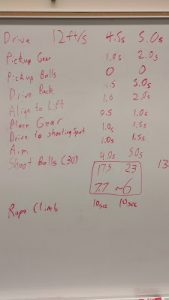We were able to do a lot of testing and iterating on our climb and amptrap mechanism today. The climb works well with some tuning left in the hook geometry. We believe we’ll be able to have a consistent climb.
Basic Climb
This will be used if we don’t want to trap in a match, or if we need to climb very quickly.
Our first attempt at the trap climb.
We were able to successfully eject the note at the trap door. However, because of the interaction of the note and polycarb panel (an AndyMark purchased trap door, with correct weights, hinge, and metal cross bar), we were unable to score the note.
Trap with Teflon on the Trap Door
We put Telfon on the trap door to see if lowering the friction would fix our problem. We also changed our geometry to push the note down at a steeper angle (just doing the angle did not fix the problem). The lower friction made it dramatically easier to score the note.
Video(there is a note already scored so it didn’t go down all the way)
Trap with Cape
After realizing we needed to reduce friction on the opposite side of the note, we quickly laser-cut a hinged cape and taped PTFE to it. This worked very well but we now have to fit this concept into our frame perimeter on the competition robot.
I did need to assist with the climb briefly as the new cape geometry doesn’t slide up the wooden wall nicely.
Amp Scoring with Cape
We did briefly score in the amp with the cape and new geometry and works well.
Conclusion
The trap is possible with the right robot but teams will need to test their mechanisms against the real polycarb door and mechanism. As the field traps wear in the friction with the note may change so it may be easier or harder to have the note slide nicely against it. Numerous other factors could come into play with the note and the trap including the note condition, how the trap doors are cleaned, and others (I wouldn’t be surprised if humidity or static build-up also affected things)
Source: Spectrum

